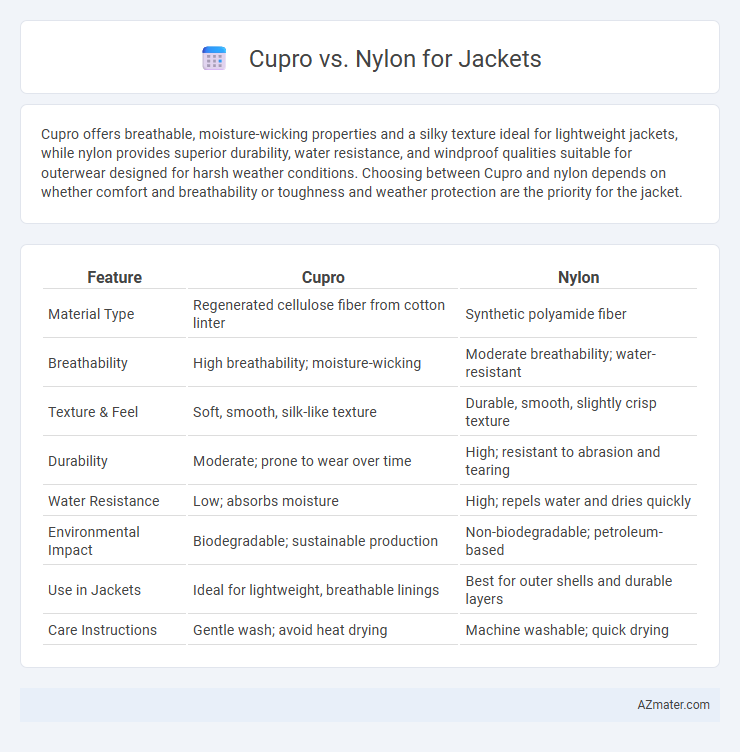Cupro offers breathable, moisture-wicking properties and a silky texture ideal for lightweight jackets, while nylon provides superior durability, water resistance, and windproof qualities suitable for outerwear designed for harsh weather conditions. Choosing between Cupro and nylon depends on whether comfort and breathability or toughness and weather protection are the priority for the jacket.
Table of Comparison
| Feature | Cupro | Nylon |
|---|---|---|
| Material Type | Regenerated cellulose fiber from cotton linter | Synthetic polyamide fiber |
| Breathability | High breathability; moisture-wicking | Moderate breathability; water-resistant |
| Texture & Feel | Soft, smooth, silk-like texture | Durable, smooth, slightly crisp texture |
| Durability | Moderate; prone to wear over time | High; resistant to abrasion and tearing |
| Water Resistance | Low; absorbs moisture | High; repels water and dries quickly |
| Environmental Impact | Biodegradable; sustainable production | Non-biodegradable; petroleum-based |
| Use in Jackets | Ideal for lightweight, breathable linings | Best for outer shells and durable layers |
| Care Instructions | Gentle wash; avoid heat drying | Machine washable; quick drying |
Introduction to Jacket Materials: Cupro vs Nylon
Cupro offers a soft, breathable, and eco-friendly fabric option derived from regenerated cellulose fibers, making it ideal for jackets that prioritize comfort and sustainability. Nylon, a synthetic polymer, is renowned for its durability, water resistance, and lightweight properties, perfect for performance-oriented outerwear. Choosing between cupro and nylon depends on whether the jacket emphasizes natural feel and biodegradability or durability and weather protection.
What is Cupro? Origins and Properties
Cupro, a regenerated cellulose fiber derived from cotton linter, is renowned for its silky texture and breathability in jacket fabrics. Originating from the process of dissolving cotton waste into a fine, smooth yarn, Cupro offers excellent moisture absorption and a soft, luxurious feel comparable to silk. Its biodegradable nature and hypoallergenic properties make it an eco-friendly alternative to synthetic fibers like nylon, which is known for durability and water resistance but lacks breathability and natural comfort.
What is Nylon? Development and Characteristics
Nylon is a synthetic polymer developed in the 1930s by DuPont, revolutionizing the textile industry with its durable and elastic properties. Characterized by high tensile strength, abrasion resistance, and quick-drying capabilities, nylon is widely used in jackets for its lightweight and water-resistant features. Its ability to retain shape and resist mildew makes nylon an ideal choice for outdoor and activewear jackets.
Cupro vs Nylon: Breathability and Comfort
Cupro offers superior breathability compared to nylon, as it is a regenerated cellulose fiber that allows better air circulation and moisture absorption, keeping the wearer cool and dry. Nylon, while durable and lightweight, tends to trap heat and moisture, making it less comfortable for extended wear in warm or humid conditions. Cupro's soft, silk-like texture enhances comfort against the skin, whereas nylon can feel more synthetic and less breathable during prolonged use.
Durability Comparison: Cupro vs Nylon
Nylon jackets outperform Cupro in durability due to their high resistance to abrasion, tearing, and water, making them suitable for rugged outdoor use. Cupro, a regenerated cellulose fiber, offers a soft, breathable feel but lacks the strength and long-term resilience found in synthetic fibers like nylon. For jackets requiring sustained durability and weather resistance, nylon remains the superior choice.
Environmental Impact: Sustainability of Cupro and Nylon
Cupro, derived from cotton waste, offers a biodegradable and eco-friendly alternative to conventional fabrics, significantly reducing textile waste and chemical use compared to petroleum-based Nylon. Nylon production involves high energy consumption and releases greenhouse gases, making its environmental footprint larger due to reliance on non-renewable fossil fuels and slow biodegradability. Choosing Cupro for jackets supports sustainability through renewable sourcing and easier degradation, while Nylon's durability comes at the cost of greater environmental impact and microplastic pollution.
Water Resistance and Weather Protection
Cupro fabric offers moderate water resistance due to its tightly woven cellulose fibers, providing breathability with slight moisture repellence ideal for light rain. Nylon excels in water resistance, featuring synthetic fibers with durable water-repellent (DWR) finishes that prevent water penetration and enhance windproofing for harsh weather conditions. Jackets made from nylon outperform cupro in weather protection, maintaining dryness and insulation during heavy rain and strong winds.
Maintenance and Care Requirements
Cupro jackets require gentle care, including hand washing or dry cleaning, to maintain their silky texture and prevent shrinking. Nylon jackets are more durable and can usually be machine washed, offering easier maintenance and faster drying times. Both materials benefit from air drying to preserve fabric integrity and prolong garment lifespan.
Style and Aesthetic Differences
Cupro fabric offers a luxurious, silky texture with a natural sheen that enhances the sophistication and elegance of jackets, making it ideal for formal or high-fashion styles. Nylon, on the other hand, provides a sleek, smooth finish with a subtle sheen that leans toward a sporty, modern aesthetic, often favored in casual or performance outerwear. The matte luster of cupro contrasts with the more synthetic look of nylon, creating distinct visual appeals suited to different style preferences and occasions.
Choosing the Right Material: Cupro or Nylon for Your Jacket
Cupro offers natural breathability and a silky texture, making it ideal for lightweight, comfortable jackets that are eco-friendly and moisture-wicking. Nylon excels in durability, water resistance, and windproof qualities, perfect for jackets designed for outdoor activities and harsh weather conditions. Choosing between Cupro and Nylon depends on prioritizing comfort and sustainability versus performance and weather protection.

Infographic: Cupro vs Nylon for Jacket
 azmater.com
azmater.com